 SLOVAK ATTRACTION SLOVAK ATTRACTION |
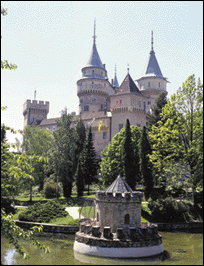
"I would qualify Slovakia as a land of discovery," stated Mr. Serge Yu, Managing Director of the Danube Hotel in Bratislava, and he was verily true. "Not only Bratislava, but every region of Slovakia has its own history with its monuments, castles," he added.
Travelling through Slovakia is not difficult, nor dangerous. Slovakia currently has about 17,700 km (about 11,000 miles) of roads, with about 450 km (about 280 miles) more planned for construction. About 3660 km (about 2274 miles) of railroad track exist, linking all of the country's major cities and many smaller towns as well. Tram and light rail networks have been developed in Bratislava and Kosice, where Slovakia's main airports are also located.
 Western Region Western Region |
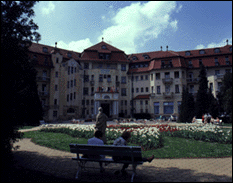
Piestany belongs among the most important and most easily accessible Slovak spa towns with important attendance of visitors from Western Europe and Middle East countries.
Endeavoring to protect the important cultural values within the town of Piestany, part of the own was declared a historical reserve in 1991. The object of protection in the reserve are especially immovable cultural monuments, an array of historical buildings on the Spa Island and other buildings that mold the color of the spa town.
 Trnava Trnava |
Trnava is Slovakia's oldest town, the first to get a royal charter as a free borough (from Hungarian King Bela IV in 1238). Though badly marred by modern development, its handsome walled old town, a legacy of almost three centuries as Hungary's religious center, was spruced up for the town's 750th birthday in 1988. Trnava was a center of the Slovak National Revival - some of the first books to use the Slovak written language were printed here. The town is friendly, low-key, cheap and almost innocent of Western tourism, making it a rewarding one-day stopover from Bratislava.
 Trencianske Teplice Trencianske Teplice |
Trencianske Teplice is a spa town in West Slovakia. Hiking trails lead into the green hills flanking the resort. There's a thermal swimming pool (open from May to September) and five hot sulfur springs in the resort itself. Those with a taste for the exotic should also visit the hammam, a Turkish bathhouse in the middle of town. Trencianske Teplice is accessible via the main railway line between Trencín and Zilina.
 Central Region Central Region |
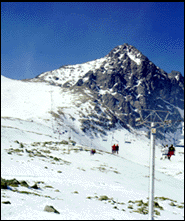
The High Tatras (Vysoke Tatry) are the only truly alpine mountains in Eastern Europe and one of the smallest high mountain ranges in the world. Narrow rocky crests soar above wide glacial valleys with precipitous walls. The lower slopes are covered by dense coniferous forest. Enhancing the natural beauty packed into this relatively small area (260 sq km/100 sq mi) are 30 valleys, almost 100 glacial lakes and numerous bubbling streams. A network of 600km (372mi) of hiking trails reaches all the alpine valleys and many peaks. The red-marked Tatranska magistrsla trail follows the southern crest of the Vysokr Tatry for 65km (40mi) through a striking variety of landscapes.
August and September are the best months for high-altitude hiking; July and August are the warmest and most crowded months. Snow can begin falling as early as September and the higher trails are closed from November to about April, when skiers flock to the area. The best center for visitors is Stary Smokovec, a turn-of-the-century resort that is well connected to the rest of the country by road and rail.
Banska Bystrica is situated in the picturesque Hron River valley, surrounded by Nizke Tatry (the Low Tatras), Velka Fatra (the Big Fatra) and Kremnicke vrchy (the Kremnica Moutains). Banska Bystrica is an important tourist point offering many possibilities for summer and winter recreation.
The first report of the town dates from the 13th century. The Hungarian King Belo IV honored the settlement by turning it into a town in 1255 and granted extensive municipal privileges in order to attract German settlers.
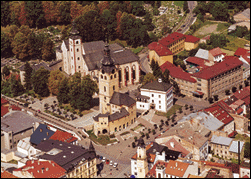
Outlanders, together with the original inhabitants Slavs developed the mining of precious metals, copper, silver and iron ores. The mining secured wealth of citizens in the 15th and the 16th century.
Since 1989 many positive changes have been carried out in the town. Many fine historic houses, representing various architectural styles, have been renovated and also the main square has regained its old-time charm.
Banska Bystrica with a population close to 100 000 residents, became the administrative, economic, cultural and educational center of the Central Slovakia. The city is a seat of Matej Bel University.
Spissky castle Please insert ( spissky Castle Door.jpg ) Picture in Basic Facts
Spissky castle (Zipser Burg) is the largest castle in Slovakia. The castle was founded in 1209, wrecked by the Tatars in the 13th century and reconstructed in the 15th century. Although the castle burnt down in 1780, the ruins and the site are spectacular. The highest enclosure contains a round Gothic tower, a cistern, a chapel and a rectangular Romanesque palace perched over the abyss. Instruments of torture are exhibited in the dungeon. The 12th-century town of Spisske Podhradie is below the castle; it's accessible via the main line from Poprad to Kosice.
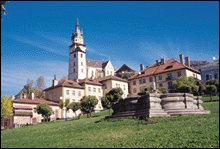
Banska Stiavnica and surroundings contain a unique system of man-made lakes connected through a network of ditches used to deliver water to mines some 500 years ago. Visit the technical museum and the museum of mining (B. Stiavnica together with Banska Bela and Kremnica were important mining towns - gold, silver, antimony). | Banska Stiavnica at one time might have been the third largest city of the Hungarian empire, probably after Budapest and Bratislava.
You can still go into an actual mine. You can also visit a museum of battles against the Turks in a lovely little castle above the town. There is a larger castle in Antol, about 5 km south that belonged to rich families related to Maria Theresia. For instance from 1826 - 1945 the famous House of Coburg (Queen Victoria etc.) was the owner of the castle, which is full of furniture, pictures, and literally thousands of trophies. You will see about 50 rooms used for different purposes. Part of the castle is now used as a museum of wood industry and hunting.
 Eastern Region Eastern Region |
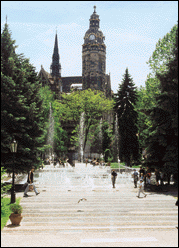
Lying in the valley of the River Hornad in the basin that shares its name, Kosice is a regional administrative center and Eastern Slovakia's hub of industry, commerce, science and culture. The country's second largest city, Kosice currently has a population of more than 250,000 inhabitants. The region of which it is administrative seat occupies an area of 6,753 km2 and has 11 district including 4 within the city itself, and 438 boroughs, of which 17 are city or urban housing estates.
Kosice is a city with an eventful and illustrious past, its earliest recorded mention dating from 1230, when it is referred to as "Villa Cassa". The coat of arms is the oldest in Europe, a fact attested to by a letter dated 1369. The city's historic sights - from various epochs - are concentrated in the historic center, which is an Urban Heritage Area.
The reconstructed main street, lined by burgher houses and palaces, offers visitors a pleasant stroll and is also the venue for major events in the life of the city.
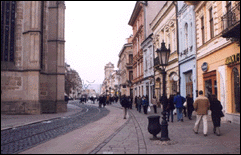
St. Elizabeth's Cathedral built between 1378 and 1508 and a Gothic masterpiece, is the city's oldest architectural landmark. Particularly imposing is the winged main altar with its three oversize statues and forty-eight panel paintings, while the lateral altars, Gothic wall paintings and sculptures add to the charm. Refurbishment work on the Cathedral is currently under way. St. Michael's Chapel located to the south of the Cathedral is a single-nave Gothic edifice from the 14th century.
Originally a cemetery chapel, it is the city's second oldest building. The Forgach palace, an eleven axial two-storied palace of the nobility built in Empire style in the early 19th century, now houses the State Science Library.
 Bardejov Bardejov |
Bardejov, the center of the Upper Sharish region is located in the northeastern part of Slovakia in the downs running along the right bank of the Topla River beneath the Lower Beskyds, 277m above the sea level. It has about 32 000 inhabitants, the extent is about 1 013 sq. km. The geographical position of
Bardejov district is: latitude 49°02'N and longitude 20°35'E. The town of Bardejov is an administrative center of Upper Sharish region; it is also a center of industry, culture and sports. It is called "the most gothic town of Slovakia". Because of outstanding urban, architectural, artistic, historic and cultural values preserved in Bardejov, it was declared an Urban Preservation area in 1950. In the year 1986 International
Board of Trustees by UNESCO, which has a seat in Hamburg, awarded Bardejov - "The European Prize - Gold Medal" for preservation and restoration. An important part of Bardejov is Bardejovske kupele - the spa, which belongs to the most visited spa centers of Slovakia. Uncommon beauty together with culture-historical sights provide the visitors not only medical treatment, but also rich cultural and social life.
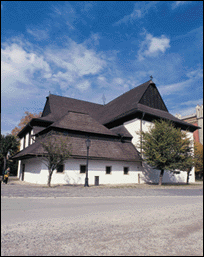
Kezmarok city castle was constructed as a defensive castle. It is first mentioned in 1463 in connection with the Zapolsky family. Its history is linked with the Tokely family, who rebuilt the original Gothic fort into an ornate Renaissance residence. They also built the baroque chapel. The castle burnt down several times in the 18th century and was repaired in the 18th and 20th centuries. General restoration work was carried out between 1962 and 1985. Since 1931 the castle has housed a museum with historical collections and exhibitions about the city and its surroundings.
 Dunajec Gorge Dunajec Gorge |
Pieniny National Park (21 sq km/8 sq mi) combines with a similar park in Poland to protect the 9km Dunajec River gorge between the Slovak village of Cerveny Klastor and Szczawnica, Poland. The river here forms the international boundary between the two countries and the 500m limestone cliffs are impressive. At the mouth of the gorge is a 14th-century fortified Cartesian Monastery, now a park administrative center and museum. There's a pleasant riverside hike through the gorge and from June to mid-September raft trips depart from a landing near the monastery. Direct buses go to Cerveny Klastor from Poprad. It's not possible to cross to Poland here.
 Roznava and surroundings Roznava and surroundings |
Roznava is 700 years old town with mining tradition (gold, silver, and copper). Old Miners Square (it really is a geometrical square) with WatchTower (used in the times of Turkish invasion) and the Museum of Minership are the main attractions. Interesting places to see in the surroundings of Roznava are: Betliar: village 6 km from Roznava - old well-known Manor house (re-opened after a long-time reconstruction) and a nice park. Krasna Horka: village 7 km from Roznava - nice big castle on the hill, last owner was the Earl Andrassy's family. Gombasek: 10 km from Roznava - cave (calcium), camping available. Domica: 20 km from Roznava - cave with an underground river (Styx) - tour on small boats, the cave has two entrances (exits) - one on the Slovak and one on the Hungarian territory, camping available. Ochtina: village 25 km from Roznava - Aragonite cave, one of the only three known aragonite caves in the world. Dobsinska Ladova Jaskyna: 35 km from Roznava - Ice cave, camping available. Dobsinska priehrada (dam): village Dedinky with a campsite. Good windsurfing, but water is too cold for swimming. Julius: 20 km from Roznava Dobsina: 25 km from Roznava Dedinky, Mlynky, Biele Vody: 35 km from Roznava - in winter good condition for skiing, in summer trekking. All these places are situated on the areas of either Slovensky raj (Slovak Paradise) or Slovensky Kras (both protected National Parks).
|

